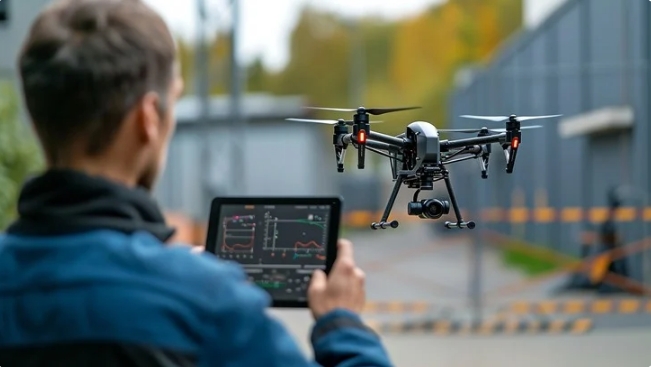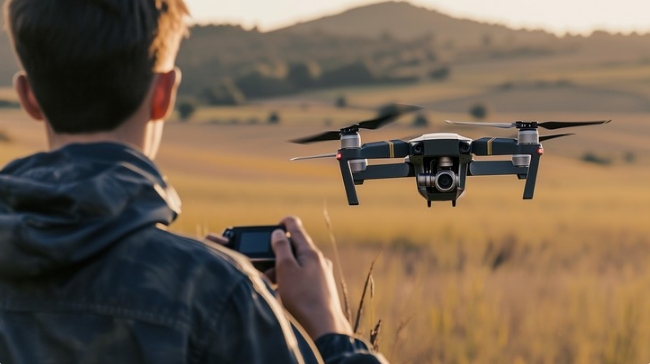
1. Ultra-High Brightness
· Brightness Levels (1000+ nits): A high-brightness display typically has a brightness rating of 1000 nits or higher. This allows the screen to remain visible even under direct sunlight, which is important for outdoor drone operations.
· Sunlight Readability: These displays are specifically designed to combat glare and reflection, ensuring that users can see their controls and live camera feed even in bright daylight or open fields.
2. Anti-Glare and Anti-Reflection Coating
· Anti-Glare Treatment: High-brightness screens often feature anti-glare coatings that reduce reflections, making them more usable in varying lighting conditions. This ensures better visibility of the drone’s live camera feed and control interface.
· Matte Finish: A matte screen finish can further reduce reflections and diffusions of ambient light, improving visibility in bright environments.
3. Wide Viewing Angles
· 160-Degree Viewing Angles: High-brightness displays often come with wide viewing angles, which allow users to view the screen clearly from various positions and angles, whether standing or sitting at different points in the operating area.
4. Enhanced Color Accuracy and Contrast
· Vibrant Colors and Clarity: High-brightness displays often include better color reproduction, providing rich and accurate colors for more precise control over camera settings, ensuring that aerial footage looks as intended.
· High Contrast Ratios: These displays provide a higher contrast ratio, which improves the visibility of details even in shadows or bright spots. This is important for inspecting structures, surveying landscapes, or capturing high-quality imagery.
5. Sunlight-Readable Touchscreen
· Responsive Touchscreen: The display typically supports touch interaction, and high-brightness models are often designed to be usable even in bright light conditions without losing touch sensitivity. This is vital for precise drone control and adjusting settings or camera controls while flying.
· Capacitive Touch: Capacitive touch technology ensures that the screen is responsive, even with gloves, which is important for drone operators working in outdoor or cold environments.
6. Durability
· Weatherproofing and Protection: To ensure reliability in harsh outdoor environments, high-brightness displays are usually built with rugged designs that are resistant to moisture, dust, and impacts (often with an IP rating of 65 or higher).
· Shockproof and Impact Resistant: Some displays are designed to absorb vibrations and shocks from drone flights, which can be important when the drone is experiencing turbulence or moving in high winds.
7. Low Power Consumption
· Efficient Power Use: High-brightness displays are often designed to balance power consumption with performance. Since drones rely on battery power, these screens are optimized for energy efficiency to help extend battery life while still providing maximum visibility.
· OLED vs. LCD for Power: OLED screens are sometimes used because of their ability to selectively light individual pixels, making them more energy-efficient in darker environments.
8. Adjustable Brightness
· Automatic Brightness Adjustment: Some displays have sensors that automatically adjust the brightness based on the surrounding light conditions, ensuring optimal visibility without the need for manual adjustments.
· Manual Brightness Control: In addition to automatic adjustments, users can often manually tweak brightness levels to ensure the screen is always optimally visible for specific lighting conditions or operational needs.
9. HD and 4K Resolution Support
· High-Definition Display (1080p or 4K): Many high-brightness displays for drones support full HD (1920x1080) or even 4K (3840x2160) resolution for enhanced clarity, especially when monitoring the drone’s camera feed or planning detailed inspections.
· High-Frame Rate Support: For smooth live-feed viewing, a high-refresh-rate display (e.g., 60Hz or higher) helps eliminate motion blur, particularly useful when tracking fast-moving subjects or flying in areas with high-speed winds.
10. Built-In Video Decoder
· Real-Time Video Feed: Many high-brightness displays come with integrated video decoders that can process live video feeds from the drone’s camera in real-time, reducing lag and enhancing the operator's ability to make instant decisions.
· Low-Latency Display: Ensures minimal delay between the drone's camera feed and what’s shown on the display, which is especially important for precise flight control and avoiding obstacles.
11. Multi-Input Support
· HDMI/USB-C Input: Some high-brightness displays feature multiple input ports (e.g., HDMI, USB-C) for flexible connection with various drone models, ground control stations, or external devices like video transmitters or additional cameras.
· Wireless Video Streaming: In some cases, wireless video streaming (e.g., Wi-Fi, 5G) may be supported, enabling more flexible setup configurations without the need for wired connections.
12. Built-In GPS and Telemetry Information
· Real-Time Telemetry Display: Many advanced drone displays include real-time telemetry (speed, altitude, battery level, GPS coordinates) overlaid on the screen. This allows the operator to monitor critical data alongside the live video feed.
· Map Integration: Some displays may integrate with mapping software, showing a live map alongside video feed to provide situational awareness in the air.
13. Modular and Portable Design
· Lightweight and Compact: For ease of transport, high-brightness displays for drones are often designed to be lightweight and compact, allowing easy mounting or handheld operation during drone missions.
· Removable or Interchangeable Batteries: Many portable high-brightness displays come with removable batteries, allowing for longer flight missions by swapping out batteries or recharging on the go.
14. Mobile App Integration
· Smartphone/Tablet Integration: Some displays work in conjunction with mobile apps, offering real-time monitoring, additional settings control, and display of more advanced telemetry or flight information.
15. Customizable UI and Overlays
· Customizable Layouts: Some high-brightness displays allow users to configure their UI, displaying key data (camera settings, telemetry, map overlays) in a customizable manner.
· Live Data Overlays: Displays may allow live data overlays (such as grid lines, flight path, or heatmaps), which is important for precise navigation and planning during tasks like surveying, mapping, or inspection.
16. Long Battery Life
· Power Optimization for Long Missions: The power management system ensures that the display consumes minimal energy without sacrificing visibility, contributing to overall drone mission efficiency and increasing operational time.
These features make high-brightness displays essential for drone operators working in various professional applications, ensuring high visibility, durability, and efficient monitoring even under challenging outdoor conditions.
Drone High-brightness Display Custom LCD Solutions for Diverse Applications
Brightness from 0-3000 for perfect display effect achievement. 100% NTSC makes the vividness of the picture better and the color transition in the picture more natural.
Color Temperature is positive white at around 5500K, warm white (yellowish) at 3500K and also cool white (cold) at 6500K.
Driver circuit with sufficient voltage and current values to meet output requirements and reduce the secondary development cycle.
Heat dissipation for high-brightness products to advance design of reasonable heat dissipation structure.
Power consumption, we increase the brightness without increasing the power consumption.
Cables, Backlighting also requires cables, either through an FPC connected to the LCD's FPC and controlled through a port, or a separate cable that controls it through a connector.LED life reached the standard of 30K hours Min. 50K, 70K, 100K hours are all achievable. 
Drone High-brightness Display Touch screen,standard type and customization

Drone High-brightness Display Driver board/adapter board, standard type and design customization
DEMO board, H-DMl board, other customized board, etc.

Drone High-brightness Display Embedded Integrated Solution
UART display solution, H-DMl display solution, Window display solution, Android display solution, Raspberry Pi solution, portable secondary screen solution, etc.
